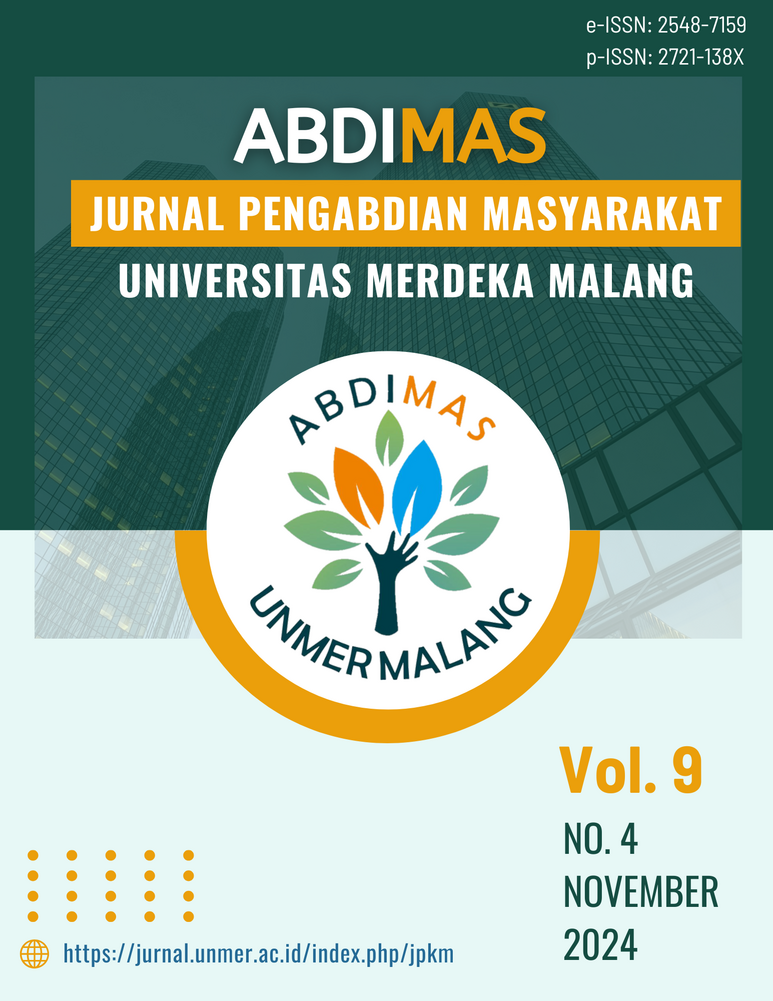SASIMI (Aquaponic System in A Circular Economy) Model with 5R Principles to address environmental pollution
DOI:
https://doi.org/10.26905/abdimas.v9i4.13973Keywords:
Aquaponic, Circular economy, Maggot cultivation, 5R principlesAbstract
The Tanusi Farmers Group in Sumberejo Village, Batu District, faced significant challenges in waste management and limited agricultural land, which hindered their ability to adopt sustainable farming practices. To address these issues, the SASIMI (Aquaponic System in Circular Economy) initiative was implemented. The system aimed to reduce waste by applying the 5R principles. It repurposed inorganic waste, such as plastic, as planting media in aquaponics and utilized maggots as biological agents to process organic waste into compost. The methodology of SASIMI included several stages, such as preparation, education on waste management and maggot cultivation, aquaponic system preparation, training on implementation and maintenance, sustainability training, and evaluation. The implementation of SASIMI yielded significant results. Maggot cultivation was able to establish 10 cultivation sites that process up to 20 kilograms of organic waste per month, converting it into compost. Additionally, 10 aquaponics systems were established, reducing 15 kilograms of plastic waste by repurposing it as planting media. Economically, the circular economy approach contributed to reducing household expenses. The aquaponics systems provided a sustainable source of fresh produce, leading to a 22 percent reduction in monthly expenditures on vegetables for participating households.
Downloads
References
Agung, A. A. G. (2015). Pengembangan model wisata edukasi-ekonomi berbasis industri kreatif berwawasan kearifan lokal untuk meningkatkan ekonomi masyarakat. Jurnal Ilmu Sosial dan Humaniora, 4(2). https://doi.org/10.23887/jish-undiksha.v4i2.6380
Atem, A., Batubara, M. Z., Sirait, M., Winatama, A., & Dores, D. (2024). Penguatan ketahanan pangan dan ekonomi perempuan melalui budidaya sayuran dan ikan dengan sistem akuaponik: Integrasi pengembangan agrowisata di Desa Bahu Palawa. Journal of Community Development, 5(3), 517-526. https://doi.org/10.47134/comdev.v5i3.1347
Handayani, L. (2018, April). Pemanfaatan lahan sempit dengan sistem budidaya aquaponik. In Prosiding Seminar Nasional Hasil Pengabdian, 1(1), 118-126. https://doi.org/10.23887/psnhp.v7i1.5310
Juliawati, P., & Reniawaty, D. (2020). Peningkatan taraf hidup masyarakat melalui pengembangbiakan maggot yang berasal dari sampah rumah tangga di kelurahan Cihaurgeulis Bandung. ATRABIS Jurnal Administrasi Bisnis (e-Journal), 6(2), 221-232. https://doi.org/10.38204/atrabis.v6i2.533
Kadir, M., Chadijah, A., Hidayati, W., & Kafrawi. (2023). Implementasi aquaponik dengan pompa tenaga surya untuk efisiensi usaha budidaya Ikan Nila pada Kelompok Tani “Mandiri” Kabupaten Sidrap Sulawesi Selatan. Jurnal Gembira: Pengabdian Kepada Masyarakat, 1(04), 1002–1009. Retrieved from https://gembirapkm.my.id/index.php/jurnal/article/view/199
Muhtarom, H. Z., Tanjung, A., & Setiawan, R. F. (2023). Peningkatan kewirausahaan dalam bidang pertanian: Strategi inovatif untuk pembangunan pertanian berkelanjutan. Journal of Community Service (JCOS), 1(3), 249-255. https://doi.org/10.56855/jcos.v1i3.596
Nawawi, N., Sriwahidah, S., & Jaya, A. A. (2018). IbKIK Budidaya Ikan Nila sistem akuaponik. Jurnal Dedikasi Masyarakat, 2(1), 37-43. https://doi.org/10.31850/jdm.v2i1.355
Nisak, F., Pratiwi, Y. I., & Gunawan, B. (2019). Pemanfaatan biomas sampah organik. Uwais Inspirasi Indonesia.
Pambudi, Y. S., & Adab, P. (2023). Mencapai pengelolaan sampah perkotaan berkelanjutan: Panduan Lengkap. Penerbit Adab.
Peraturan Walikota Batu. (2020). Pedoman pengelolaan sampah. Retrieved from: https://peraturan.bpk.go.id/Details/149241/perwali-kota-batu-no-66-tahun-2020
Raihan, M. A. (2022). Potensi maggot sebagai pengurai limbah organik. Retrieved from: https://dspace.uii.ac.id/handle/123456789/42227
Ridwan, A. (2015). Tanggapan pengunjung terhadap Wisata Petik Sayur Desa Sumberejo Kota Batu. http://mulok.lib.um.ac.id/index.php?p=show_detail&id=72274&keywords=
Rusdianto, A. S., Aldini, A. S., Wulandari, F., Fauziayah, D. N., Marella, L. N., Ratnawati, A., ... & Zuhdi, A. R. (2023). Fish pellet development utilizing BSF Maggot by-product organic fertilizer for economic growth. Abdimas: Jurnal Pengabdian Masyarakat Universitas Merdeka Malang, 8(4), 526-537. https://doi.org/10.26905/abdimas.v8i4.11436
Sartika, S. B., & Cahyani, C. R. (2023). Education and assistance in hydroponic plant cultivation for strengthening the self-reliant economy. Abdimas: Jurnal Pengabdian Masyarakat Universitas Merdeka Malang, 8(2), 243-251. https://doi.org/10.26905/abdimas.v8i2.9588
Sompotan, D. D., & Sinaga, J. (2022). Pencegahan pencemaran lingkungan. SAINTEKES: Jurnal Sains, Teknologi Dan Kesehatan, 1(1), 6-13. https://doi.org/10.55681/saintekes.v1i1.2
Sugianto, N., Angraini, M., & Utama, F. P. (2022). Penerapan teknologi aquaponic pada kelompok usaha bersama. CARADDE: Jurnal Pengabdian Kepada Masyarakat, 5(2), 339-347. https://doi.org/10.31960/caradde.v5i2.1363
Wibowo, I. K., Marta, B. S., Susanto, E., Bachtiar, M. M., Widarto, M. F. E., Hanan Asy-syaf’ie, A., & Romolo, R. A. (2023). SLiCE: Implementation of automation technology and Internet of Things in the greenhouse. Abdimas: Jurnal Pengabdian Masyarakat Universitas Merdeka Malang, 8(2), 315-325. https://doi.org/10.26905/abdimas.v8i2.9816
Yuana, S. L. (2023). Mundane circular economy policy: Peta kebijakan dan kriteria sekolah sirkular di level pendidikan dasar. Indonesian Perspective, 8(1), 180-205. https://doi.org/10.14710/ip.v8i1.56384
Yulianyahya, R. W. (2022). Optimalisasi feses/kotoran dari budidaya ternak ikan sebagai sumber nutrisi tanaman dengan sistem aquaponik. Pengmasku, 2(1), 76-84. https://doi.org/10.54957/pengmasku.v2i1.197
Downloads
Published
How to Cite
Issue
Section
License
Copyright (c) 2024 Abdimas: Jurnal Pengabdian Masyarakat Universitas Merdeka Malang

This work is licensed under a Creative Commons Attribution-ShareAlike 4.0 International License.
Authors who publish with this journal agree to the following terms:
- Copyright of the published articles will be transferred to the journal as the publisher of the manuscripts. Therefore, the author confirms that the copyright has been managed by the journal.
- Publisher of Abdimas: Jurnal Pengabdian Masyarakat Universitas Merdeka Malang is University of Merdeka Malang.
- The copyright follows Creative Commons Attribution-ShareAlike License (CC BY SA): This license allows to share, copy, and redistribute the material in any medium or format, adapt, remix, transform, and build upon the material, for any purpose, even commercially.





